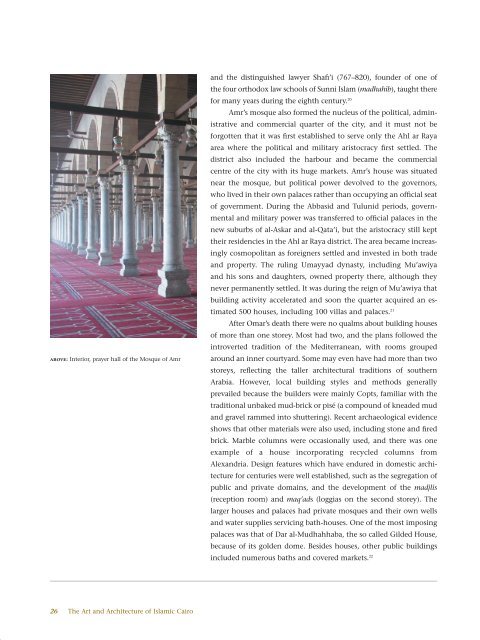The Art And Architecture of Islamic Cairo
The Art And Architecture of Islamic Cairo
The Art And Architecture of Islamic Cairo
You also want an ePaper? Increase the reach of your titles
YUMPU automatically turns print PDFs into web optimized ePapers that Google loves.
above: Interior, prayer hall <strong>of</strong> the Mosque <strong>of</strong> Amr<br />
26 <strong>The</strong> <strong>Art</strong> and <strong>Architecture</strong> <strong>of</strong> <strong>Islamic</strong> <strong>Cairo</strong><br />
and the distinguished lawyer Shafi’i (767–820), founder <strong>of</strong> one <strong>of</strong><br />
the four orthodox law schools <strong>of</strong> Sunni Islam (madhahib), taught there<br />
for many years during the eighth century. 20<br />
Amr’s mosque also formed the nucleus <strong>of</strong> the political, admin-<br />
istrative and commercial quarter <strong>of</strong> the city, and it must not be<br />
forgotten that it was first established to serve only the Ahl ar Raya<br />
area where the political and military aristocracy first settled. <strong>The</strong><br />
district also included the harbour and became the commercial<br />
centre <strong>of</strong> the city with its huge markets. Amr’s house was situated<br />
near the mosque, but political power devolved to the governors,<br />
who lived in their own palaces rather than occupying an <strong>of</strong>ficial seat<br />
<strong>of</strong> government. During the Abbasid and Tulunid periods, governmental<br />
and military power was transferred to <strong>of</strong>ficial palaces in the<br />
new suburbs <strong>of</strong> al-Askar and al-Qata’i, but the aristocracy still kept<br />
their residencies in the Ahl ar Raya district. <strong>The</strong> area became increasingly<br />
cosmopolitan as foreigners settled and invested in both trade<br />
and property. <strong>The</strong> ruling Umayyad dynasty, including Mu’awiya<br />
and his sons and daughters, owned property there, although they<br />
never permanently settled. It was during the reign <strong>of</strong> Mu’awiya that<br />
building activity accelerated and soon the quarter acquired an estimated<br />
500 houses, including 100 villas and palaces. 21<br />
After Omar’s death there were no qualms about building houses<br />
<strong>of</strong> more than one storey. Most had two, and the plans followed the<br />
introverted tradition <strong>of</strong> the Mediterranean, with rooms grouped<br />
around an inner courtyard. Some may even have had more than two<br />
storeys, reflecting the taller architectural traditions <strong>of</strong> southern<br />
Arabia. However, local building styles and methods generally<br />
prevailed because the builders were mainly Copts, familiar with the<br />
traditional unbaked mud-brick or pisé (a compound <strong>of</strong> kneaded mud<br />
and gravel rammed into shuttering). Recent archaeological evidence<br />
shows that other materials were also used, including stone and fired<br />
brick. Marble columns were occasionally used, and there was one<br />
example <strong>of</strong> a house incorporating recycled columns from<br />
Alexandria. Design features which have endured in domestic architecture<br />
for centuries were well established, such as the segregation <strong>of</strong><br />
public and private domains, and the development <strong>of</strong> the madjlis<br />
(reception room) and maq’ads (loggias on the second storey). <strong>The</strong><br />
larger houses and palaces had private mosques and their own wells<br />
and water supplies servicing bath-houses. One <strong>of</strong> the most imposing<br />
palaces was that <strong>of</strong> Dar al-Mudhahhaba, the so called Gilded House,<br />
because <strong>of</strong> its golden dome. Besides houses, other public buildings<br />
included numerous baths and covered markets. 22











